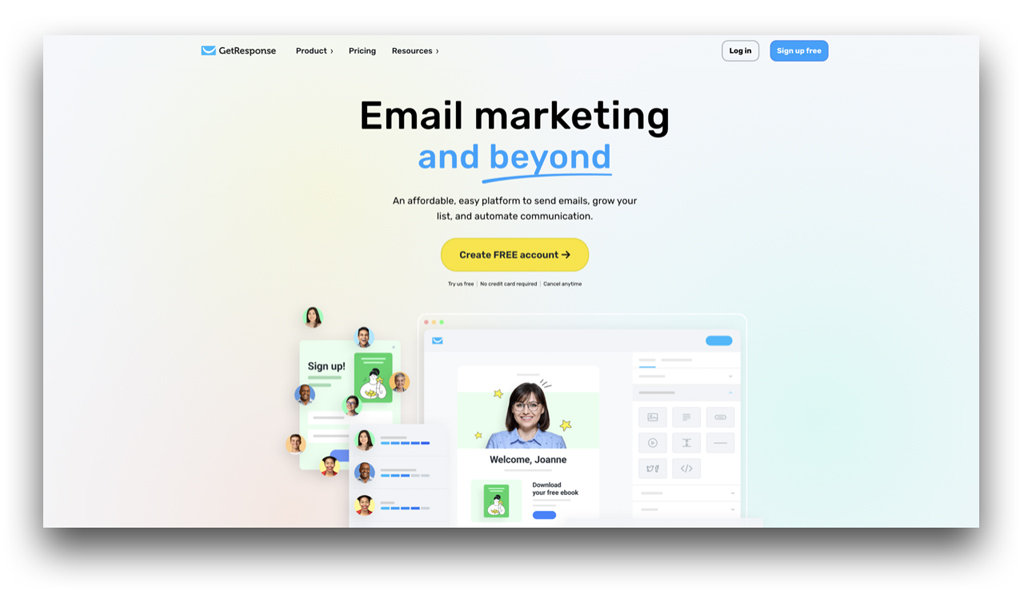GetResponse is a comprehensive email marketing platform that empowers businesses of all sizes to create, send, and track email campaigns with ease. With its user-friendly interface and advanced features, GetResponse provides marketers with the tools they need to effectively engage with their target audience and drive measurable results.
In today's digital landscape, email marketing remains a powerful and cost-effective communication channel for businesses. By leveraging the benefits of email marketing, organizations can increase their reach, personalize their messaging, build stronger customer relationships, and track the return on their marketing investments.
While personal email services like Gmail can be utilized for limited marketing purposes, they often lack the robust features and capabilities found in dedicated email marketing platforms like GetResponse. This article will explore the benefits of email marketing, the limitations of using Gmail for marketing, and the comprehensive features and capabilities of GetResponse that make it a compelling choice for businesses seeking to optimize their email marketing strategies.
Benefits of Email Marketing
>>> CLICK HERE <<<
Increased Reach
Email marketing allows businesses to reach a wide audience quickly and cost-effectively. Unlike traditional marketing methods, email enables companies to distribute their messages to a large number of potential customers or existing clients with minimal effort and expense. This increased reach helps businesses expand their customer base, maintain consistent communication, and stay top-of-mind with their target audience.
Personalized Communication
One of the key advantages of email marketing is the ability to personalize communication with each recipient. By leveraging customer data and segmentation capabilities, businesses can tailor their email content, offers, and messaging to the specific needs and preferences of their audience. This personalization not only enhances engagement but also improves conversion rates, as recipients are more likely to respond to messages that feel relevant and tailored to their interests.
Improved Customer Relationships
Regular email communication fosters stronger relationships with customers. By consistently providing valuable content, updates, and offers, businesses can build brand loyalty, nurture leads, and keep their customers engaged. This ongoing interaction helps to establish trust, increase customer lifetime value, and generate repeat business.
Measurable ROI
Email marketing campaigns provide detailed analytics and reporting, allowing businesses to track the performance of their campaigns and optimize their strategies for greater effectiveness. Key metrics such as open rates, click-through rates, conversion rates, and revenue generated can be easily measured, enabling marketers to make data-driven decisions and continuously improve their email marketing efforts.
Using Gmail for Marketing Purposes
While Gmail is a popular and widely used personal email service, it can also be utilized for limited marketing purposes. However, it is important to note that Gmail's capabilities and features are not specifically designed for advanced email marketing, and businesses may find certain limitations when using it for marketing purposes.
Lack of Advanced Features
Gmail, as a personal email service, lacks the comprehensive features and automation capabilities that are typically found in dedicated email marketing platforms like GetResponse. This includes features such as advanced segmentation, A/B testing, email scheduling, and comprehensive campaign management tools, which are essential for executing effective and scalable email marketing strategies.
Limited Segmentation
Gmail's segmentation options are relatively basic, making it challenging for businesses to target specific groups of subscribers with tailored content and offers. In contrast, email marketing platforms like GetResponse offer robust segmentation capabilities, allowing marketers to create highly targeted campaigns based on various subscriber data points, such as demographics, interests, engagement levels, and purchase history.
Spam Filtering
Emails sent from Gmail accounts may face higher spam detection rates compared to emails sent through dedicated marketing platforms. Email service providers and spam filters are often more lenient towards messages from recognized marketing platforms, as they have established reputations and follow email marketing best practices.
While Gmail can be used for limited marketing purposes, businesses that are serious about leveraging the full potential of email marketing are better off using a dedicated platform like GetResponse, which provides a comprehensive suite of features and tools to enhance the effectiveness and efficiency of their email marketing efforts.
GetResponse Features for Email Campaigns
GetResponse is a powerful email marketing platform that offers a wide range of features and capabilities to help businesses create, send, and track successful email campaigns. Some of the key features of GetResponse include:
>>> CLICK HERE <<<
Email Builder
GetResponse's user-friendly email builder allows marketers to easily design visually appealing and responsive email templates. The drag-and-drop interface enables quick and efficient creation of custom email layouts, with the ability to incorporate a variety of content elements, such as text, images, videos, and calls-to-action.
List Management and Segmentation
GetResponse provides advanced list management and segmentation tools, enabling businesses to organize their contacts into targeted groups based on various criteria, such as demographics, interests, behavior, and past interactions. This granular segmentation allows for the delivery of highly personalized and relevant content to each subscriber.
Automated Workflows
GetResponse's automation capabilities enable businesses to set up automated email sequences, known as workflows. These workflows can be triggered by specific user actions, such as signing up for a newsletter, making a purchase, or abandoning a shopping cart. Automated workflows help nurture leads, keep customers engaged, and provide a more personalized experience.
Split Testing and Analytics
GetResponse offers robust split testing and analytics features, allowing marketers to experiment with different elements of their email campaigns, such as subject lines, content, and calls-to-action. The comprehensive reporting dashboard provides detailed insights into campaign performance, enabling data-driven optimization and improved ROI.
Landing Pages and Forms
In addition to email marketing, GetResponse also includes a landing page builder and form creation tools. These features allow businesses to create high-converting landing pages and opt-in forms to capture leads and drive conversions.
Integrations and API
GetResponse seamlessly integrates with a wide range of popular business tools and platforms, including CRM systems, e-commerce platforms, and social media networks. The platform also offers a powerful API, enabling developers to build custom integrations and automate various marketing processes.
By leveraging these comprehensive features, businesses can create highly effective email marketing campaigns, automate their marketing workflows, and gain valuable insights to drive growth and success.
Integration of GetResponse with Gmail
While GetResponse is a standalone email marketing platform, it also offers integration capabilities with Gmail, allowing businesses to leverage the benefits of both platforms. This integration can provide several advantages:
Centralized Contact Management
GetResponse's integration with Gmail enables users to synchronize their Gmail contacts directly with their GetResponse lists. This centralized contact management simplifies the process of maintaining up-to-date subscriber data and ensures consistent communication across both platforms.
Email Capture from Gmail
The GetResponse integration with Gmail allows users to capture email addresses directly from their Gmail inbox, making it easier to grow their subscriber lists. Users can easily add new contacts to their GetResponse lists, ensuring that all potential leads are properly nurtured through email marketing campaigns.
Gmail Inbox Delivery
By using GetResponse's email delivery infrastructure, businesses can improve the deliverability of their email campaigns to their Gmail subscribers. GetResponse's reputation as a trusted email marketing platform can help ensure that messages bypass spam filters and reach the intended recipients' inboxes.
Unified Email Workflow
The integration between GetResponse and Gmail enables users to manage their entire email marketing workflow from a single platform. This includes creating and sending campaigns, tracking performance, and accessing subscriber data – all while leveraging the familiarity and convenience of the Gmail interface.
Seamless Collaboration
For businesses with teams that utilize both GetResponse and Gmail, the integration can facilitate seamless collaboration. Shared access to contact lists, campaign analytics, and email content can enhance teamwork and streamline email marketing efforts.
By integrating GetResponse with Gmail, businesses can combine the robust email marketing capabilities of GetResponse with the convenience and user-familiarity of the Gmail platform, creating a powerful and efficient email marketing solution.
Best Practices for Email Marketing with GetResponse
To ensure the success of email marketing campaigns using GetResponse, it's essential to follow best practices. Here are some key considerations:
List Building and Segmentation
Building a targeted and engaged email list is crucial. GetResponse provides various list-building tools, such as opt-in forms and landing pages, to help businesses capture qualified leads. Segmenting the email list based on customer data and behavior can enable more personalized and effective campaigns.
Content Creation and Optimization
Creating high-quality, valuable content is key to engaging subscribers and driving results. GetResponse's email builder and design tools make it easy to create visually appealing and responsive emails. Businesses should also optimize their content for readability, mobile responsiveness, and clear calls-to-action.
Automation and Workflows
Leveraging GetResponse's automation and workflow features can help businesses nurture leads, retain customers, and drive repeat business. Automated email sequences, triggered by user actions, can provide a personalized and consistent experience for subscribers.
A/B Testing and Optimization
GetResponse's split testing capabilities allow businesses to experiment with different subject lines, content, and design elements to determine the most effective approach. Continuous testing and optimization can lead to improved open rates, click-through rates, and overall campaign performance.
Deliverability and Reputation Management
Maintaining a good email sender reputation is crucial for ensuring high deliverability rates. GetResponse provides tools and guidance to help businesses adhere to email marketing best practices, such as maintaining a clean subscriber list, providing clear opt-out options, and avoiding spam-like content.
Integration and Data Synchronization
Integrating GetResponse with other business tools, such as CRM systems, e-commerce platforms, and web analytics, can provide a holistic view of customer data and facilitate data-driven decision-making. Ensuring seamless data synchronization across these integrations can enhance the effectiveness of email marketing campaigns.
By following these best practices and leveraging the powerful features of GetResponse, businesses can create and execute highly effective email marketing strategies that drive engagement, conversions, and long-term customer relationships.
Analyzing Email Marketing Performance with GetResponse
Measuring the performance of email marketing campaigns is essential for understanding their impact and making data-driven decisions. GetResponse offers a comprehensive suite of analytics and reporting tools to help businesses track and optimize their email marketing efforts.
Campaign Performance Metrics
GetResponse's reporting dashboard provides a detailed overview of key email marketing metrics, including open rates, click-through rates, bounce rates, unsubscribe rates, and conversion rates. These metrics help businesses understand the overall engagement and effectiveness of their campaigns.
Subscriber Engagement Analytics
GetResponse also offers in-depth analytics on subscriber engagement, such as tracking which subscribers are most active, which content is resonating best, and which segments are most responsive. This data can inform content and targeting strategies to improve subscriber engagement over time.
Revenue and ROI Tracking
For businesses focused on driving revenue through email marketing, GetResponse provides tools to track the financial impact of their campaigns. This includes the ability to measure revenue generated, average order value, and return on investment (ROI) for each email campaign or automation workflow.
Comparative Analysis
GetResponse's reporting capabilities allow businesses to compare the performance of different email campaigns, test variations, and analyze trends over time. This enables data-driven decision-making and helps optimize future email marketing efforts.
Integration with Analytics Platforms
GetResponse can be integrated with popular web analytics tools, such as Google Analytics, to provide a more comprehensive view of the customer journey and the impact of email marketing on overall business performance.
By leveraging the advanced analytics and reporting features of GetResponse, businesses can gain valuable insights, make informed decisions, and continuously improve the effectiveness of their email marketing strategies.
Personalization in Email Marketing with GetResponse
Personalization is a crucial aspect of effective email marketing, as it helps businesses create more engaging and relevant experiences for their subscribers. GetResponse offers a range of personalization features that can enhance the impact of email campaigns.
Dynamic Content
GetResponse's dynamic content capabilities allow businesses to personalize email content based on subscriber data, such as name, location, interests, and past interactions. This enables the creation of highly targeted and tailored messages that resonate with individual recipients.
Behavioral Segmentation
By monitoring subscriber behavior and engagement patterns, GetResponse enables businesses to segment their email lists based on actions, such as website visits, product views, cart abandonment, and previous purchases. This granular segmentation allows for the delivery of personalized content and offers that are more likely to drive conversions.
Personalized Subject Lines and Previews
GetResponse provides options to personalize email subject lines and preview text, which can significantly impact open rates. Incorporating subscriber-specific information, such as their name or recent interactions, can increase the relevance and perceived value of the email.
Triggered Campaigns
GetResponse's automation features allow businesses to set up triggered email campaigns that are initiated by specific user actions or events. These triggered campaigns, such as welcome messages, abandoned cart reminders, and post-purchase follow-ups, create a more personalized and timely experience for subscribers.
Personalized Landing Pages
In addition to email personalization, GetResponse's landing page builder enables businesses to create customized landing pages that align with the content and messaging of their email campaigns. This consistent and personalized experience across touchpoints can enhance conversion rates and strengthen brand recognition.
By leveraging the personalization capabilities of GetResponse, businesses can create more engaging, relevant, and effective email marketing campaigns that resonate with their target audience and drive measurable results.
Automating Marketing Processes with GetResponse
GetResponse's powerful automation features enable businesses to streamline and scale their marketing efforts, saving time and resources while delivering a more personalized experience to their subscribers.
Automated Workflows
GetResponse's workflow builder allows businesses to create automated email sequences triggered by specific user actions or events. These workflows can be used for lead nurturing, customer onboarding, abandoned cart recovery, and a variety of other marketing scenarios, ensuring timely and relevant communication with subscribers.
Autoresponders
GetResponse's autoresponder feature enables the creation of automated email series, such as welcome messages, nurture campaigns, and educational content. These pre-scheduled emails can be customized and personalized to provide a consistent and valuable experience for new and existing subscribers.
Segmentation-Based Automation
By leveraging GetResponse's advanced segmentation capabilities, businesses can create highly targeted automation workflows. For example, they can set up automated campaigns based on subscriber interests, purchase behavior, or engagement levels, ensuring that each recipient receives the most relevant content and offers.
Lead Scoring and Qualification
GetResponse's lead scoring and qualification features allow businesses to automatically assess the engagement and sales-readiness of their leads. This information can then be used to trigger specific automated actions, such as sending personalized content, assigning leads to sales teams, or adjusting nurturing sequences.
E-commerce Automation
For businesses with e-commerce operations, GetResponse provides integrations and automation capabilities to streamline the email marketing process. This includes automated order confirmations, product recommendations, and post-purchase follow-ups, all of which can be tailored to individual customer behavior and preferences.
By automating various marketing processes with GetResponse, businesses can save time, improve the consistency and relevance of their communication, and focus their efforts on more strategic initiatives while still delivering a personalized and engaging experience to their subscribers.
GetResponse vs. Other Email Marketing Platforms

When it comes to choosing an email marketing platform, businesses have several options to consider. While GetResponse is a comprehensive and feature-rich solution, it's important to understand how it compares to other leading email marketing platforms in the market.
Mailchimp
Mailchimp is a popular email marketing platform known for its user-friendly interface and a wide range of free and paid plans. However, GetResponse often outperforms Mailchimp in terms of advanced features, automation capabilities, and overall email marketing functionality.
Constant Contact
Constant Contact is another well-known email marketing platform that offers a solid set of features. However, GetResponse typically provides more robust segmentation, A/B testing, and reporting capabilities, making it a stronger choice for businesses seeking a more data-driven and customizable email marketing solution.
HubSpot
HubSpot is a leading marketing and sales platform that also offers email marketing capabilities. While HubSpot provides a comprehensive suite of tools, GetResponse is often more cost-effective and specialized in its email marketing features, making it a preferred choice for businesses focused on optimizing their email marketing strategies.
ActiveCampaign
ActiveCampaign is known for its advanced automation and customer relationship management (CRM) features. While ActiveCampaign and GetResponse both excel in automation, GetResponse may be a more suitable option for businesses that prioritize ease of use, visual email design, and comprehensive email marketing functionality.
Drip
Drip is a specialized email marketing platform focused on e-commerce and marketing automation. While Drip offers robust e-commerce integrations, GetResponse provides a more well-rounded set of features, including landing pages, webinars, and CRM capabilities, making it a viable alternative for businesses with diverse marketing needs.
When evaluating email marketing platforms, businesses should consider their specific requirements, such as the size of their subscriber base, the complexity of their marketing needs, the level of automation and personalization required, and the desired level of integration with other business tools. By comparing the features and capabilities of GetResponse against other leading platforms, businesses can make an informed decision that aligns with their strategic email marketing objectives.
Conclusion

GetResponse is a comprehensive email marketing platform that provides businesses with the tools and features necessary to create, execute, and optimize effective email marketing campaigns. By leveraging the benefits of email marketing, businesses can reach a wider audience, personalize their communication, build stronger customer relationships, and track the measurable return on their marketing investments.
While personal email services like Gmail can be used for limited marketing purposes, GetResponse offers a more robust and specialized set of features that are designed to enhance the effectiveness and efficiency of email marketing efforts. From advanced list management and segmentation to powerful automation and reporting capabilities, GetResponse empowers businesses to deliver personalized and engaging experiences to their subscribers.
By following best practices and leveraging the full capabilities of GetResponse, businesses can create email marketing strategies that drive tangible results, such as increased brand awareness, lead generation, customer retention, and revenue growth. Additionally, the platform's integration with Gmail and other business tools can further streamline marketing workflows and provide a more







